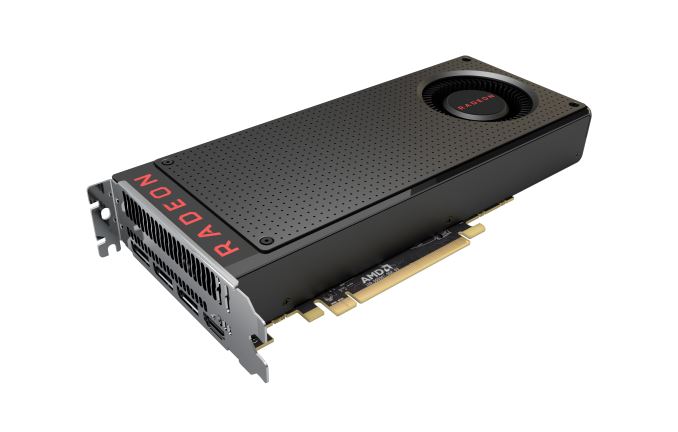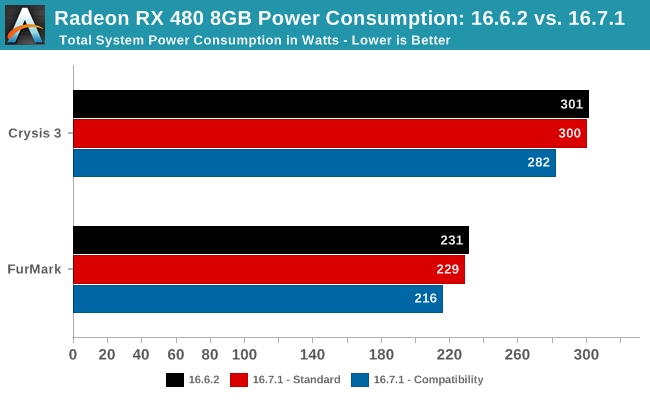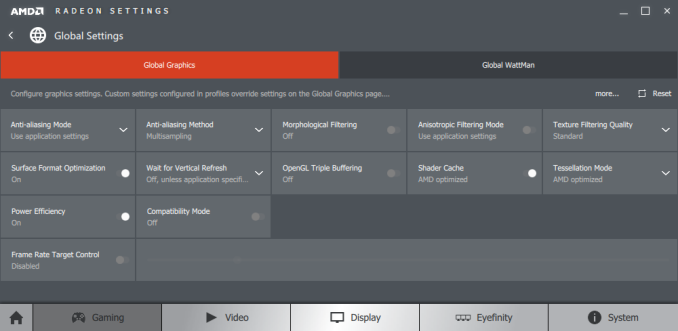AMD Posts Radeon 16.7.1 Drivers, Fixes RX 480 Power Consumption Issues
by Ryan Smith on July 7, 2016 6:50 PM EST
In what’s hopefully the final chapter on AMD’s saga over the last week with the Radeon RX 480’s power consumption, AMD has posted the previously promised 16.7.1 driver set on their website.
As a reminder, 16.7.1 is being released first and foremost to address RX 480’s power consumption issues, in which reviewers found that it was drawing too much power from the PCIe graphics (PEG) slot, and that the total power consumption of the card was at times exceeding 150W, which is the technical limit for a card with a 6-pin power connector. Of the two issues, PEG power consumption is arguably the greater of the two, as the external power connectors are far more forgiving.
To that end, 16.7.1 rolls out a two tier solution to the problem.
- Shift some of the power load off of the PCIe Graphics (PEG) slot connector in order to bring PEG slot power consumption within the PCIe spec. This doesn’t reduce total power consumption and performance is unaffected; power delivery is merely shifted. Based on earlier data this will put the 6-pin connector further over spec, but the vast majority of PSUs are very tolerant of this going out of spec.
- Because total power consumption of RX 480 can still exceed 150W – and as a result also exceed the limits for the 6-pin connector – AMD has also implemented an optional a “compatibility” toggle that reduces the total power consumption of the card. This is to better ensure that both the PEG slot and 6-pin power connector stay below their respective limits. Since the RX 480 is already throttling at times due to power limits, this does hurt performance (more on that below), but it's also the most standards-compliant solution.
Along with the power changes, the driver also incorporates some previously scheduled bug fixes and performance improvements. This includes fixing GTA V stuttering, and small performance boosts for a limited number of games that AMD states should improve performance by up to 3%.
Finally, the 16.7.1 driver can be found on AMD’s website. Note that the driver itself is not WHQL certified, but given AMD’s rush to get it out ASAP, I don’t imagine they were interested in waiting for WHQL certification to come back before releasing them.
Diving into matters then, PC Perspective has already taken a look at the new driver and done individual power rail measurements, finding that AMD’s fixes work more-or-less as advertised. They have found some edge cases where the card is still drawing a watt or two more power from the PEG slot than the specification allows, though at this point we’re arguing over inches. It should be noted however that even in compatibility mode, PC Perspective is still finding that power consumption is technically exceeding 75W on the 6-pin connector, though like the PEG slot by notably less than when not using compatibility mode.
Meanwhile to look at the performance impact of the new driver, I quickly ran our RX 480 through a selection of games at 2560x1440, both with and without compatibility mode.

In standard mode where power consumption isn’t curtailed, performance is essentially unchanged outside of Tomb Raider, which is one of the games targeted for optimization. Essentially this proves that there’s no performance impact from merely shifting power consumption off of the PEG slot to the 6-pin power connector.
Meanwhile in compatibility mode, there is a very small performance hit, though it varies with the game. Compared to standard mode, we’re looking at no more than a 1fps performance drop (~3%), with some games losing only a fraction of a frame per second. That there is a performance drop is consistent – so compatibility mode isn’t free – but overall the performance change is within the +/- 2% margin of error for these benchmarks.

Finally, when it comes to power consumption, measurements at the wall back up our earlier findings. In standard mode, power consumption at the wall bobbles by a couple of watts compared to the 16.6.2 drivers. With compatibility mode on, we see power consumption drop by 18W under Crysis 3, and 13W under FurMark. The average GPU clockspeed in both cases is similarly reduced, with Crysis 3 shaving off around 50MHz.
Anyhow, we’ll have a bit more on the subject in next week’s full Radeon RX 480 review. But in the meantime it looks like AMD has been able to get a handle on their power problems and largely rectify them within the span of a week, making for a fairly quick recovery on the RX 480’s launch fumble.











105 Comments
View All Comments
fxv300 - Friday, July 8, 2016 - link
my PSU 12Volt is rated as such +12V 42A = 504WattsI have been using the RX480 for a couple of days now and most power drawn I hav seen is about 40Watts.... check out my video here showing GPU-Z stats
https://youtu.be/tyX7k3EbjPo
BlueBlazer - Saturday, July 9, 2016 - link
GPUZ does not show the overall power consumption of the entire card. Also those tests (in the video) will not stress the GPU much at all.The_Assimilator - Friday, July 8, 2016 - link
*sigh*"The 75W rating for 6-pin and 150W rating for the 8-pin are not true ratings."
Except that they are, because those are the power limits set by the PCIe specification. Someone could build a system with a motherboard that only ever allows up to 75W to be drawn from the PCIe slot, and pair it with a PSU that only ever allows up to 75W to be drawn from the 6-pin PEG connector. Both those components would be completely compliant with the specification, but if you tried to run an RX 480 in this system, the system would fail (perhaps spectacularly) because the card is not compliant - and this would be entirely AMD's fault.
Now, you are correct that most people who buy RX 480 will have motherboards and power supplies that are overbuilt and will have no issue running the card. But that isn't the point! The point is that we have electrical specifications for a very good reason - so that our PC components actually work together without burning each other out, or worse.
AMD has already played fast and loose with the PCIe spec back in the R9 295 X2 days, but that was mostly okay because the only people who bought those cards had monster PSUs and high-end motherboards with built-in protections. The RX 480 is targeted at a much wider audience and some of those will have computers that aren't as forgiving of specification violations - Dell and HP OEM systems come to mind, for a start. Tell me, if those users' computers fail when using an RX 480, is it their fault, or AMD's?
Stop making excuses for AMD. They f**ked up, plain and simple, and if people like you keep defending them and buying their products instead of calling them out on their bulls**t, they won't bother to fix their f**kups going forward, which means consumers will continue getting substandard products. Are you happy with that? Because if you are, I've got a bridge to sell you.
fanofanand - Friday, July 8, 2016 - link
Dell and HP OEM PC's typically do not have GPU's that use a PEG connector. Those that do will have power supplies that can handle it. The sky is not falling. AMD is certainly playing fast and loose, but no need to dramatize it.Outlander_04 - Friday, July 8, 2016 - link
https://www.reddit.com/r/Amd/comments/4rbw8p/facts...PCI-e x 16 slots are electrically good for 300 watts [ unless you put the computer in an oven ]
So scary one might have to pull 80 watts
BlueBlazer - Saturday, July 9, 2016 - link
Look further down the thread for comments debunking the OP's false claims. Actual specifications http://suddendocs.samtec.com/catalog_english/pcie.... says "2.2 A per pin (2 adjacent pins powered)". This means 1.1A per pin just like the standard Molex and PCI Express specifications. From Molex http://www.molex.com/pdm_docs/ps/PS-87715-200.pdf manufacturer follows exactly PCI Express specifications.BlueBlazer - Friday, July 8, 2016 - link
That's hovering near the maximum limits of PCI Express specifications. Still worse than all other graphic cards which draws way below that amount of current on average. Looks like the VRM configuration is main culprit.emn13 - Friday, July 8, 2016 - link
The spec allows a 8% margin of error on that figure, so that's actually compliant. Why would the spec even bother to mention 5.5A? No idea.miribus - Friday, July 8, 2016 - link
If AMD connected all of the power and ground wires on their end, use a 6+2 connector instead of a 6 and you're within spec.Outlander_04 - Friday, July 8, 2016 - link
https://www.reddit.com/r/Amd/comments/4rbw8p/facts...No issue now, no issue then . The card was certified
You can stop worrying now